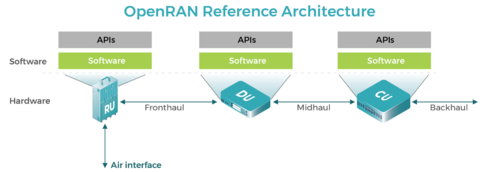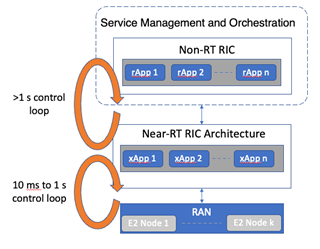Summary
Next-generation Radio Access Networks (RANs) are characterized by the disaggregation of the network elements and the use of intelligent controllers to manage the increased complexity of radio technologies and network deployments.
The disaggregation of the network elements to create an Open RAN that allows the equipment from different vendors to communicate requires well-defined, standardized interfaces. Furthermore, the increased complexity of the network and the need for real-time control forces the network operators to investigate automated solutions based on Machine Learning (ML) algorithms. The standardization effort is being led by the O-RAN Alliance, an international community of mobile network operators, vendors, and research and academic institutions operating in the RAN industry. NIST, also a member of the O-RAN Alliance, is well-positioned to assist the telecom industry by developing methodologies and tools to assess the interoperability and performance of Open RAN solutions.
Description
Network Disaggregation

An Open RAN gNB is a decentralized gNB and consists of three parts, each with its own hardware/software: Radio Unit (RU); Distributed Unit (DU); Control Unit (CU). Each unit in Open-RAN takes over a section of gNB tasks. The RU has the responsibility of transmitting and receiving RF data. The DU takes the LTE/NR layer 2 responsibility and is between RU and CU. Finally, the CU takes over the higher LTE/NR layer responsibilities.
Intelligent Control

The real time monitoring and optimization of the network requires the introduction of intelligent controllers. There are two types currently described in the O-RAN framework: a near-real time (RT) controller that receives event notifications and measurements information from the RAN nodes (e.g., CU, DU, and RU) and issues command to optimize the network. A non-RT controller is also defined to decide on the overall network operating policies to deploy based on information received from the near-RT controllers and operators’ intent. In each type of controllers are custom applications that process the information and decide actions to take. Operators or third parties can develop and use those applications to fit their specific needs. Because next generation RANs are so flexible, they are controlled by thousands of parameters. Combined with the ever-increasing number of towers being deployed, it is necessary to use ML-based algorithms that can react quickly to known and unknown changes in the network.
Technical Objectives and Research Opportunities
The industry and the research community face several technical objectives associated with an Open RAN system. Those include:
- Performance. There are potential performance limitations due to the disaggregation of the network elements. Control functions and data must be carried over the network, which can create additional overhead and longer latencies compared to traditional solutions. A new network, separate from the user plane, and the use of special GPU cards to run ML algorithms, are potential approaches that might be needed. However, those approaches could also increase energy consumption.
- Security. The data transmitted needs to be secured and the various network elements also need to be trusted. Mixing and matching different vendors, using open-source software, and combining public and private cloud providers can potentially create new vulnerabilities.
- Interoperability. The success of Open RAN relies greatly on the adoption of the standards and implementation by multiple vendors.
These objectives are well understood by industry and other technical stakeholders, who continue to make progress in addressing them. NIST research is part of a larger effort by U.S. Government entities to catalyze the development and adoption of open, interoperable, and standards-based networks. This includes the U.S. Commerce Department’s National Telecommunications and Information Administration Public Wireless Supply Chain Innovation Fund, a ten-year grant program that will help drive wireless innovation, foster competition, and strengthen supply chain resilience. Other agencies such as Department of Homeland Security and Department of Defense are also supporting Open RAN research and development.
NIST's Open RAN Research Focus Areas
In addition to utilizing standard 5G New Radio technology, the open interface concept aims to boost U.S. manufacturing of cellular network hardware by providing a platform for vendor interoperability; cellular carriers will no longer be locked into a single vendor when they purchase their network equipment. This architecture also helps to alleviate a critical national security risk by increasing on-shore technology development and manufacturing.
To accelerate the development and adoption of Open RAN solutions, NIST is focusing on the following areas:
- Data-Driven Network Optimization for Future Wireless Systems
- Enable the evaluation of Machine Learning (ML) algorithms for network automation and RAN optimization.
- Support the development of datasets for training and validating ML models.
- Open-Source Wireless Testbed
- This testbed, located on the Gaithersburg NIST Campus, will focus on open-source implementations of the 5G components of the network infrastructure. This will allow finer control and understanding of the network and its performance, but also allow us to enhance the implementations, develop new functionalities, and contribute back to the community.
- Advanced Security Architectures for Next Generation Wireless
- This project works with mobile wireless, internet and virtual computing industry to improve the security and resilience of emerging designs for 56 / 6G core networks and radio access networks (RANs). Our current work focuses on enhancing the security properties of emerging O-RAN Alliance standards for 5G Open-RAN and disaggregated virtualized core networks.
- Interoperability and Optimization
- NIST’s research will focus on developing measurement methods to quantify the ability of different vendors to interoperate with each other – a key tenant of the Open RAN architecture. NIST aims to develop rigorous, reliable, scientific strategies to define and quantify interoperability in concert with the Open RAN community.
- Beyond interoperability, NIST aims to develop tools to enable network operators to optimize a multi-vendor Open RAN system and maximize performance.
- Utilize the 5G Coexistence Testbed, located on the Boulder NIST Campus, with the newest generation of end-to-end 5G New Radio technology, including mm-Wave capabilities. In 2022, a 5G Open RAN system consisting of a base station radio unit, a distributed unit, a centralized unit, and a network core was added to the testbed. This new Open RAN system will be used in conjunction with the chambers and infrastructure of our existing 5G Coexistence Testbed and NBIT.

